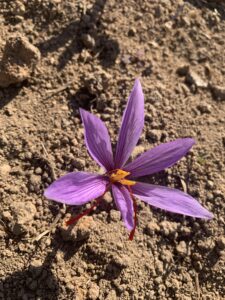Project Overview
Information Products
Commodities
- Agronomic: saffron
Practices
- Crop Production: varieties and cultivars
- Farm Business Management: new enterprise development
Abstract:
Crocus sativus L, commonly known as “saffron” is a perennial stem-less fall-blooming geophyte in the Iridaceae family. Renowned as "red gold," saffron stands as one of the most expensive spices by weight. Recent scientific interest in saffron has surged due to its potential therapeutic applications in combating cancer cells, Alzheimer's disease, and cardiovascular disorders. Similarly, the cultivation of saffron presents a promising avenue for smaller agricultural enterprises, offering opportunities for economic enhancement and sustainability through innovative production systems and diversified operations. However, saffron remains largely unexplored in the southern regions, particularly among underserved and small-scale producers. The primary objective of this project was to evaluate saffron as an alternative crop in Georgia by assessing its agronomic performance under different production systems and planting schedules at the Southeast Organic Center (SOC) during the 2023 and 2024 growing seasons. Saffron was cultivated under two conditions—open field and low plastic tunnel—with both early (September Planting) and late (October Planting) planting dates. In 2023, a total of 1,907 flowers were harvested, yielding 59.61 grams of fresh stigma. However, yields declined significantly in 2024, with only 961 flowers and 22.89 grams of stigma. This reduction could be attributed to the absence of compost application in the second year and a decrease in plant population due to the failure of some corms to sprout. Both production systems showed these declines: flower production in the open field dropped from 917 to 503 and in the low tunnel from 990 to 458, with corresponding stigma yields decreasing from 28.36 to 12.11 grams and 31.2 to 10.78 grams, respectively. Planting time also influenced performance; early planting in 2023 yielded 937 flowers (27.68 g), and late planting produced 970 flowers (31.92 g), whereas in 2024, early and late plantings yielded 549 (12.92 g) and 412 flowers (9.97 g), respectively. Despite the reduced yields in the second year, economic analysis indicated that saffron could generate a net revenue of $5,189 per 0.25-acre plot over two years. Profitability is expected to improve over time with better agronomic practices, such as soil fertility enhancement, compost use, irrigation management, and increased daughter corm production. In 2024 and 2025, we conducted three webinars, presented at three national and international conferences, and published a peer-reviewed article. The project was also featured at the SOC’s annual field day on 19th September 2024, attended by 73 participants. Ongoing laboratory analyses will evaluate saffron quality by quantifying key secondary metabolites—crocin (C₄₄H₆₄O₂₄), picrocrocin (C₁₆H₂₆O₇), and safranal (C₁₀H₁₄O)—across production systems and time. Overall, this study demonstrates that saffron has strong potential as a high-value alternative crop for small-scale growers in the southeastern U.S., particularly when supported by strategic agronomic practices.
[caption id="attachment_1073850" align="alignright" width="188"] Photo: Saffron flower at Rodale Institute Southeast Organic Center, Georgia[/caption]
Photo: Saffron flower at Rodale Institute Southeast Organic Center, Georgia[/caption]
Project objectives:
This project showcases a novel and sustainable method to produce high-quality saffron in the southern region. Our focus is on organic production, but the results will be useful for no-organic producers as well. Our objectives are to:
- Evaluate different production systems and planting dates for saffron production in southern states
- Evaluate the best method of processing saffron stigma for small-scale producers (using oven vs. microwave)
- Develop an enterprise budget to document the feasibility of saffron production in the region